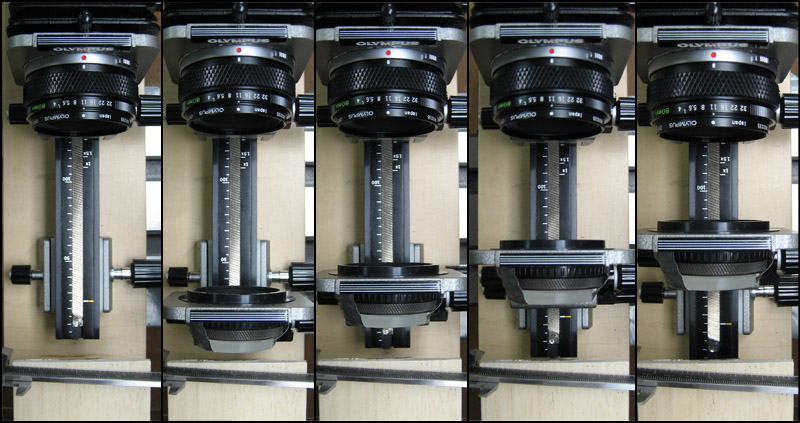Recall that one of the definitions of a telecentric lens system is "the entrance pupil (apparent position of the aperture) is at infinity".
In my earlier postings, I made that happen primary by adding an auxiliary diaphram, so that the limiting aperture fell at the rear focal point of existing lens elements.
In this post, I take the alternative approach of adding a lens element between the existing lens and the subject. With proper strength and position, the added lens causes the existing aperture to appear at infinity.
Here's the concept.

The thing called "Normal Lens" is the existing lens. I've diagrammed it here as a thin lens, with its aperture at its center. In reality, the Normal Lens would be thick, with lots of glass between the aperture and the subject. It really doesn't matter where the aperture physically is, just where it appears to be. Those converging rays point to where it appears to be.
The added lens has focal length f_added, and it's positioned exactly that far away from the previous entrance pupil position. If you look upward through the added lens with a telescope, the aperture will focus at infinity.
The choice of f_added is not critical, though there are some constraints. It has to be short enough that you can fit the added lens between the normal lens and the subject, while the system as a whole is refocused on the farthest depth. And it needs to be long enough that it can have decent diameter and still not introduce aberrations. Ignoring illumination, the best added lens would be the longest possible, fitting right against the subject at deepest focus. Illumination considered, some shorter length may be a better choice.
I prototyped several variations of this scheme today, and I'll show you the best one. The first few were done with fancy lenses, and while illustrative they weren't exactly compelling. Then I happened to remember the little box of lenses that I bought ages ago for the kids to play with. Lo and behold, in one envelope there was a partially delaminated achromat of just the right size to work with. Sometimes you get lucky...
The lens system that I'm going to make telecentric is a closeup rig consisting of an 80 mm lens on just enough bellows to reach 1:1. That puts the subject around 160 mm in front of the lens (and the sensor 160 mm behind it).
The added lens is a basic achromat with focal length around 140 mm, and a diameter of 37 mm. That length puts it just barely in front in the focus plane when it's positioned to give perfect telecentricity, and the diameter is more than enough to surround my entire 22.7x15.1mm field.
It turns out, of course, that perfect telecentricity may not be needed. In the grand scheme of stack-and-stitch, the computer can give us perfectly parallax-free geometry simply by refusing to scale images to compensate for differences between focus planes. It's OK if the optics produce a slight change in magnification with distance -- that change just has to be small enough that there's no significant lateral movement of image features from the depth that they start to come into focus, until the depth they go out.
So in addition to testing at the perfect position, I also tested with the added lens at progressively more approximate positions.
Here are the test configurations. The slanted bar at the bottom is the mm scale of a vernier caliper, seen edge-on.

The left column is the system with no added lens. These optics are very far from telecentric -- the entrance pupil is smack in the middle of the lens. The second column has the added lens in its perfect telecentric position. Subsequent columns move the added lens into positions that are less and less telecentric.
And the results... (drum roll, please)

All columns are using Helicon Focus, autoadjustment turned off. What's shown here are actual pixels of the upper left corner of the full frame (rotated 90 degrees to line up with the configuration photos). Focus step 0.020 in, f/11 on the aperture ring.
As you can see, the left column is completely unacceptable. The optical system has so much magnification change within the DOF slab that stacking without scale adjustment produces terrible "echoing". In contrast, the perfectly telecentric system shows no echos and is quite clear. The third column seems completely acceptable as well. At roughly 10% off from perfectly telecentric, it's providing a 10X reduction in magnification change within the DOF slab. We don't start to see noticeable degradation until the fourth and fifth columns, which at 20% and 30% off from perfectly telecentric, are providing only 5X and 3X reduction in magnification change.
A couple of points worth noting. First, the added lens makes only a modest change in total system magnification, particularly when it's close to the subject. Second, the added lens does not need to be very high quality, again, particularly when it's very close to the subject so that the ray cones are only going through a small part of the added lens. It is important that the added lens be an achromat. A simple lens acts like a prism toward the edges of the field, and you get severe color fringing.
It's late, and I don't know what to add at this point.
Questions, comments?
--Rik
Edit: corrected typo about column numbering.
